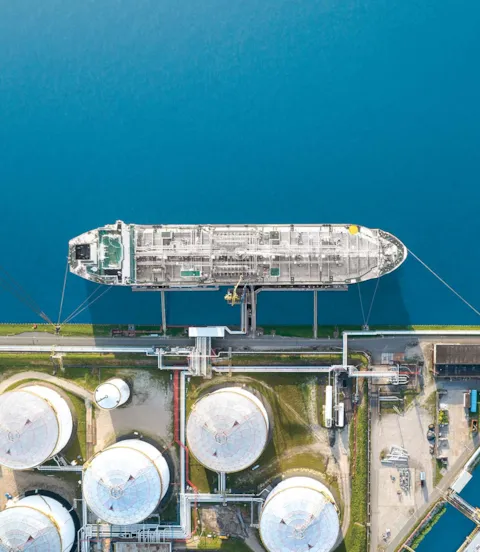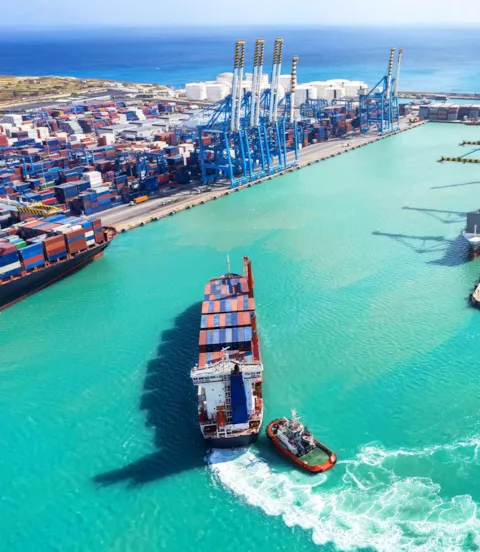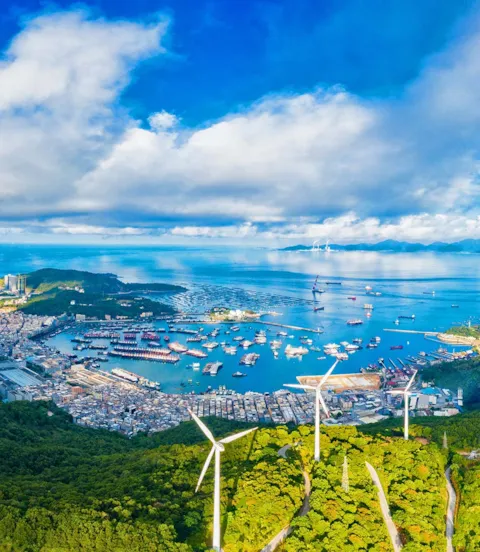Collaboration is key to scale up fuel availability in time
DNV’s latest Maritime Forecast to 2050 urges cooperation across and beyond the industry to meet net-zero targets for shipping. It models future fuel availability to assist decisions on ship design, operations and infrastructure developments that will determine if maritime effectively and safely achieves current and future IMO decarbonization ambitions.
“The energy and technology transition in maritime is gathering pace but has far to go to meet even IMO’s initial decarbonization ambitions for international shipping,” says Eirik Ovrum, Maritime Principal Consultant at DNV and lead author of Maritime Forecast to 2050. “For one thing, supply chains will have to change dramatically to make sufficient carbon-neutral fuels available where and when they are needed.”

Fuelling the ongoing maritime energy transition
“Shipping could face competition from other industries for the ideal carbon-neutral fuels. Big decisions are needed about the best use of such fuels for reducing global carbon emissions. Our latest Maritime Forecast to 2050 report investigates which carbon-neutral fuels are likely to be available for large-scale maritime use,” Ovrum continues. “We find a need for strong collaborative initiatives with and beyond the sector to maximize opportunities and reduce the risks of the coming fuel transformation.”
The starting point is that DNV expects existing, forthcoming and proposed IMO and EU regulations and decisions to have a major impact on ship design and operations. IMO’s 2023 revision of its Initial Greenhouse Gas Strategy could involve faster and deeper decarbonization ambitions. Decarbonization frameworks and standards also drive transition. Examples include science-based, net-zero greenhouse gas (GHG) emissions targets; taxonomies defining what activities can be called “sustainable”; sustainability evaluation criteria and calculation methods for the well-to-wake GHG emissions of fuels; and supply-chain emission reporting requirements.

The maritime energy transition is gathering pace
The maritime industry is not playing “wait and see” as regulation shifts and targets are set. Some shipowners are already deciding how to future-proof newbuilds for sustained, sustainable and safe operation however regulatory and other drivers shift by 2030 and/or 2050. Applying DNV’s Carbon-Risk Framework, updated in 2021 and 2022, continues to support such decision-making. Stakeholders such as banks, insurers, investors and cargo owners are also driving the transition by stepping up pressure for ship designs and operations that will reduce the carbon footprint of transporting goods by sea.
Our report confirms the accelerating trend towards larger newbuild ships being ordered with alternative fuel propulsion, with fossil liquefied natural gas (LNG) dominant for now (see Figure 2).
Around 5.5% gross tonnage (GT) of ships operating today, and a third on order, can or will be able to operate on alternative fuels – including LNG. The statistics are also starting to show an uptake of methanol and liquefied petroleum gas (LPG) fuel technologies and hydrogen-fuelled newbuilds.
“This is an encouraging start, but ship and cargo owners, finance, ports, fuel providers, energy majors and governments need greater clarity on what the future fuel mix will be, and when the relevant fuel technologies will be ready to use,” says Ovrum. “Our latest modelling offers research-based foresight around both these questions. We base our analysis of availability on what we see as the likely supply chain and infrastructure constraints on carbon-neutral fuel use in ships.” Figure 3 visualizes the main questions surrounding these constraints.

Which carbon-neutral fuels will be available to shipping?
Sustainable biomass would be the preferred fuel in an ideal world, mainly because it is relatively easy to convert to energy-dense hydrocarbon fuels such as bio-LNG, bio-methanol and bio-MGO. Other hard-to-abate sectors like aviation will also want energy-dense hydrocarbons, however. If supply cannot meet demand, sustainable biomass could be expensive compared with electrofuels and blue fuels.
Electrofuel (e-fuel) availability depends on having sufficient renewable electricity supply to produce “green” hydrogen by electrolysis. Yet the transition from fossil energy to renewables is still slow or non-existent in most global regions. Electrolysis powered even partly from fossil fuels is not energy-efficient and could lead to higher net-carbon emissions in a maritime fuel value chain.
The availability of blue fuels, made from fossil fuels with carbon capture, hinges on how effectively the carbon is captured, and on having infrastructure for permanently storing this carbon. Mature carbon capture and storage (CCS) technology and infrastructure could also make on-board CCS a viable alternative where ships continue to use fossil fuels.
Sourcing sustainable carbon from biogenic sources or direct air capture could also become important. Combining such carbon with green hydrogen could produce relatively energy-dense fuels such as e-diesel, e-methane and e-methanol.
Maritime Forecast to 2050 applies our enhanced model of the development of the global fleet to investigate how the future fuel mix will be affected by the availability of sustainable biomass, renewable electricity, CCS for making blue fuels, and sustainable carbon. Figure 3 summarizes these factors determining the availability of carbon-neutral fuel.
We also assess fuel costs by region, and how regional fuel production and infrastructure impact the future fuel mix. The findings and practical implications of this exploration of the fuel transition facing shipping are covered in our report and will be summarized in a later Maritime Impact article.

Which alternative fuel technologies will be available when?
Maritime Forecast to 2050 also presents an updated timeline showing current and anticipated maturity levels of several on-board fuel technologies between now and the mid-2030s. Technology readiness levels (TRLs) range from validated (TRL 4) to those available from one or more manufacturers (TRL 9).
The timeline now includes a separate assessment of different energy converters, on-board CCS and safety regulations for the design and on-board use of alternative fuels. Using new fuels and fuel technologies will require all maritime industry stakeholders to focus increasingly on safety and to develop and implement relevant safety regulations. The low end of the scale for safety regulation maturity indicates a complete lack of prescriptive international standards to support designers and yards with newbuilding. A high maturity level is assigned where it is possible to base statutory approval on accepted international standards.
“We would expect technologies and power ranges serving core markets to become available first, followed by an expansion in product range depending on demand,” says Ovrum.

Digitalization enabling the transition
Digitalization is the other major transformative force alongside decarbonization in shipping today, and the two go hand in hand. Digital tools can deliver up to 15% of GHG emission savings required by 2050. Our report discusses how this may be achieved through digital tools enabling more energy-efficient ship design, construction and operation through model-based simulation and optimization.
We anticipate greater use of increasingly sophisticated digital twins. These virtual ships model all on-board equipment, machinery, networks and control systems, connecting and integrating them in cyberspace. Potential benefits include optimizing GHG performance for ships in operation through monitoring, better routing and planning, diagnostic and corrective actions and simulator-based crew training. Similarly, digital twins could optimize fleet utilization and GHG performance by simulating and optimizing fleet size, composition and speed.

Collaboration key to an effective energy transition
The analysis and modelling in Maritime Forecast to 2050 underline how achieving ambitions for decarbonizing shipping will depend critically on collaboration across the maritime value chain and with other industries.
For example, the technology maturity timeline described above assumes that the fuels are available and that there is market demand for the respective fuel technologies. “Many other factors will of course affect the actual uptake of these technologies,” says Ovrum. “Examples include distribution and bunkering infrastructure, infrastructure enabling CCS if needed, policies and incentive schemes, fuel prices and technology costs.”
About 5% of energy for shipping should come from carbon-neutral fuels in 2030. The fuel infrastructure transition needed to deliver the 270 million tonnes of alternative fuels that would be needed for full maritime decarbonization by 2050 is a mammoth challenge. “This will all require huge investment in on-board technologies and onshore,” observes Ovrum.

How much will decarbonization cost?
Maritime Forecast to 2050 estimates that USD 8–28 billion (bn) additional total investment per year will be needed just on ships to achieve decarbonization by 2050. USD 30bn to 90bn per year would also be needed to scale onshore production, fuel distribution and bunkering infrastructure sufficiently to supply 100% carbon-neutral fuels by mid-century. The more expensive energy sources and onshore investments could drive up annual sector fuel costs by more than USD 100bn to 150bn when fully decarbonized – a 70 to 100% increase from today. We therefore estimate that decarbonizing shipping completely by 2050 will require about 2.5 times more investment than under current IMO ambitions.
“The scale and scope of the challenge mean we absolutely need strong alliances to push the development of fuel supply chains,” concludes Ovrum. “Charterers, energy majors, fuel suppliers, governments, ports and shipowners should collaborate to ensure adequate funding for the right projects. It could spell opportunity for first movers to launch projects making large volumes of alternative fuels available where and when needed. Green shipping corridors can help to unlock this opportunity and reduce the risk of infrastructure obsolescence as the fuel mix shifts.”

- Sepia100 - stock.adobe.com
- DNV 2022
- Getty Images/iStockphoto
- Shutterstock / Weiming Xie